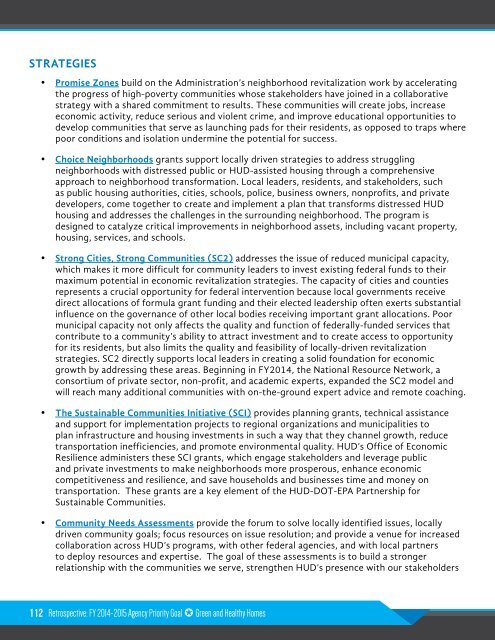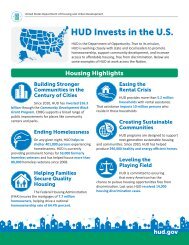Annual Performance Plan 508
Annual Performance Plan 508
Annual Performance Plan 508
Create successful ePaper yourself
Turn your PDF publications into a flip-book with our unique Google optimized e-Paper software.
STRATEGIES<br />
• Promise Zones build on the Administration’s neighborhood revitalization work by accelerating<br />
the progress of high-poverty communities whose stakeholders have joined in a collaborative<br />
strategy with a shared commitment to results. These communities will create jobs, increase<br />
economic activity, reduce serious and violent crime, and improve educational opportunities to<br />
develop communities that serve as launching pads for their residents, as opposed to traps where<br />
poor conditions and isolation undermine the potential for success.<br />
• Choice Neighborhoods grants support locally driven strategies to address struggling<br />
neighborhoods with distressed public or HUD-assisted housing through a comprehensive<br />
approach to neighborhood transformation. Local leaders, residents, and stakeholders, such<br />
as public housing authorities, cities, schools, police, business owners, nonprofits, and private<br />
developers, come together to create and implement a plan that transforms distressed HUD<br />
housing and addresses the challenges in the surrounding neighborhood. The program is<br />
designed to catalyze critical improvements in neighborhood assets, including vacant property,<br />
housing, services, and schools.<br />
• Strong Cities, Strong Communities (SC2) addresses the issue of reduced municipal capacity,<br />
which makes it more difficult for community leaders to invest existing federal funds to their<br />
maximum potential in economic revitalization strategies. The capacity of cities and counties<br />
represents a crucial opportunity for federal intervention because local governments receive<br />
direct allocations of formula grant funding and their elected leadership often exerts substantial<br />
influence on the governance of other local bodies receiving important grant allocations. Poor<br />
municipal capacity not only affects the quality and function of federally-funded services that<br />
contribute to a community’s ability to attract investment and to create access to opportunity<br />
for its residents, but also limits the quality and feasibility of locally-driven revitalization<br />
strategies. SC2 directly supports local leaders in creating a solid foundation for economic<br />
growth by addressing these areas. Beginning in FY2014, the National Resource Network, a<br />
consortium of private sector, non-profit, and academic experts, expanded the SC2 model and<br />
will reach many additional communities with on-the-ground expert advice and remote coaching.<br />
• The Sustainable Communities Initiative (SCI) provides planning grants, technical assistance<br />
and support for implementation projects to regional organizations and municipalities to<br />
plan infrastructure and housing investments in such a way that they channel growth, reduce<br />
transportation inefficiencies, and promote environmental quality. HUD’s Office of Economic<br />
Resilience administers these SCI grants, which engage stakeholders and leverage public<br />
and private investments to make neighborhoods more prosperous, enhance economic<br />
competitiveness and resilience, and save households and businesses time and money on<br />
transportation. These grants are a key element of the HUD-DOT-EPA Partnership for<br />
Sustainable Communities.<br />
• Community Needs Assessments provide the forum to solve locally identified issues, locally<br />
driven community goals; focus resources on issue resolution; and provide a venue for increased<br />
collaboration across HUD’s programs, with other federal agencies, and with local partners<br />
to deploy resources and expertise. The goal of these assessments is to build a stronger<br />
relationship with the communities we serve, strengthen HUD’s presence with our stakeholders<br />
112 Retrospective: FY 2014-2015 Agency Priority Goal Green and Healthy Homes



